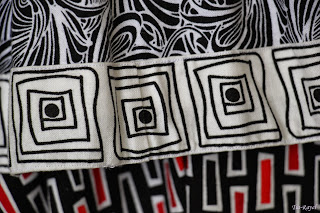When I added
-isms: understanding fashion to my sewing library there was one dress in particular that caught my eye. It was a 1972 gown designed by Bill Gibb and worn by the singer Sandie Shaw (who, I’m afraid, I’d never heard of) and used in the book as an example of ‘World Clothing’.
The
original design is described as incorporating influences from medieval dress, folk costumes and the hippy movement. When I was working out how I would interpret this design I decided that I wanted to avoid the earthy colours of the original and instead juxtapose the hippy design with more distinct/futuristic/tech-society colours: black and white with red highlights.
 |
| I still wanted to have a pair of busy dark/light prints and a box-patterned trim |
We scoured the local quilting shops for coordinating prints and eventually found a set that went together nicely. I omitted the dangly embroideries on the sleeves and bodice of the original dress. For the front of my dress I made a slashed feature panel.
 |
| I achieved this look by alternating layers of black and white fabric; sewing lots of parallel lines across them and then cutting all but the bottom layer of fabric in between the stitching. |
For some reason I didn’t find any information for this dress online when I was making it. Things I didn’t know included: there are two lines of boxes down the front of the skirt (I don’t think I had enough fabric for that), the original dress is lined and it closes with a back zip.
I’m pretty sure my mum told me to put a zip in it and I refused
(“zips haven’t been invented yet” will be what I scribble on walls should I ever go mad) and my decision has resulted in a dress that is a bit looser than it might otherwise have been and is difficult to get on and off (especially at the mid sleeve gather-point – although the zip wouldn’t have changed that). On the bright side, at least the back isn’t broken up by an ugly zip – because I didn’t know about invisible zippers then. (
There are 3 types of zip in the world – featured, invisible and ugly.)
 |
| I’m not sure why my waistline ended up being so much lower than the original – it’s something I only noticed when writing this post. |
About the time I made this dress I was becoming dissatisfied with the quality of my sewing. I had been using many shortcuts, so for this dress I decided to do things properly. This was the first piece for which I ironed out the seams during construction and finished each edge separately. It was a big improvement, but looking at it now it is still quite rough in places.
 |
| Notice how carefully the box is matched at the seam and how neatly the stitching lines fit between the print and the edge of the fold. |
I can’t find the pattern I made but my recollection is that it was adapted from a vest pattern combined with many rectangles. Maybe I only used measurements for the rectangles and the reason I can’t find a pattern is that one never existed.











